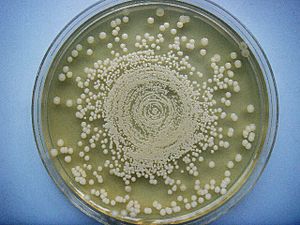Jane Hinton facts for kids
Quick facts for kids
Jane Hinton
|
|
|---|---|
 |
|
| Born | May 1, 1919 |
| Died | 9 April 2003 (aged 83) |
| Alma mater | |
| Known for |
|
Jane Hinton (1919–2003) was a very important scientist. She helped discover how to test if bacteria are resistant to antibiotics. She was also one of the first two African-American women to become a Doctor of Veterinary Medicine (VMD) in 1949.
Before she studied to be a vet at the University of Pennsylvania, she worked in a lab at Harvard. There, she helped create the Mueller-Hinton agar. This is a special gel used to grow bacteria. It helps scientists see if bacteria can be stopped by antibiotics. Later, she worked as a vet for small animals in Massachusetts. She also worked as a government inspector. Jane Hinton's father, William Augustus Hinton, was also a famous scientist. He was the first African-American professor at Harvard University.
Early Life and School
Jane Hinton was born on May 1, 1919. Her father, William Augustus Hinton (1883-1959), studied bacteria (a bacteriologist) and diseases (a pathologist). His parents had been slaves. He became the first African-American professor at Harvard University. He also wrote the first textbook by an African-American author.
He went into lab medicine because of racism in Boston. Racism meant he could not get a medical internship, even though he was qualified. Jane Hinton's mother was Ada Hawes (born 1878). She was a high school teacher and a social worker. Jane's parents married in 1909. They had two daughters, Jane and Ann. Jane Hinton finished college at Simmons College in 1939 when she was 20 years old.
Her Amazing Career
In 1931, Jane's father started a course on medical lab techniques. This course was open to women, which was unusual at the time. Jane Hinton worked in Harvard's labs. She helped John Howard Mueller create the Mueller-Hinton agar. This special gel was made to grow a type of bacteria called Neisseria. This bacteria causes a serious illness called meningitis.
Mueller and Hinton found that adding starch to the agar helped the bacteria grow better. It also stopped toxins from the bacteria from messing up antibiotic tests. This agar became the most common way to grow Neisseria. In the 1960s, scientists found it was also great for testing if bacteria were sensitive to antibiotics.
Today, a group called the Clinical and Laboratory Standards Institute sets the best lab rules. They decided that the Kirby-Bauer method, which uses Mueller-Hinton agar, is the best way to test antibiotics. This is called the gold standard.
During World War II, Hinton also worked as a lab technician in Arizona. After the war, she studied to become a veterinarian. She earned her Doctor of Veterinary Medicine (VMD) degree from the University of Pennsylvania in 1949. She and Alfreda Johnson Webb were the first two African-American women to become veterinarians. Alfreda Webb graduated from the Tuskegee Institute (now Tuskegee University) in the same year.
Before Jane Hinton, only four African-American people had graduated from the University of Pennsylvania's vet school. After her, no other African-American person graduated until 1968. Hinton and Webb were also the first African-American members of the Women's Veterinary Medicine Association.
After getting her degree, Hinton worked as a vet for small animals in Canton, Massachusetts. Later, she became a federal government inspector in Framingham, Massachusetts.
In 1984, Jane Hinton and John Taylor were honored. John Taylor was the first African-American graduate of the University of Pennsylvania's vet school. They were recognized during the school's 100th birthday celebration by the Minority Veterinary Students association.
Jane Hinton passed away on April 9, 2003.
See also
 In Spanish: Jane Hinton para niños
In Spanish: Jane Hinton para niños


